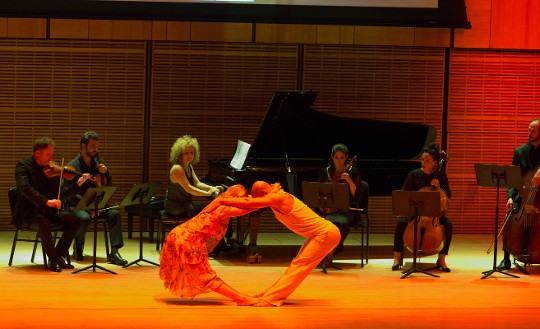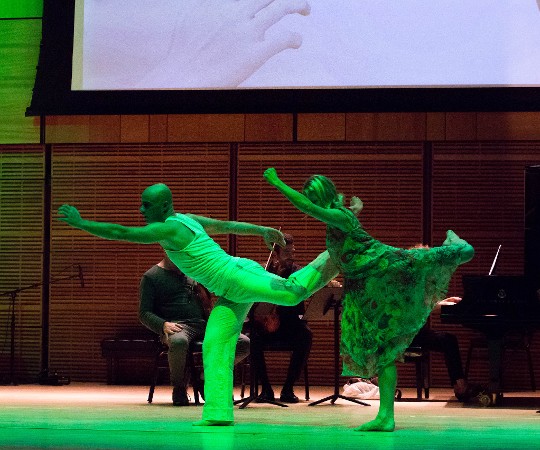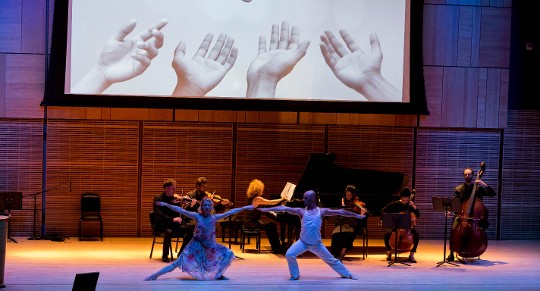Contextual Matters
Motivation
It occurred to Gloria Benedikt, Science and Art Research Associate at IIASA, that a compelling theme for artistic investigation could be the Institute’s research on the complexity inherent in the integrated implementation of the Sustainability Goals (SDGs).
No scientific assessment to date had established the feasibility of implementing all 17 goals—ranging from ending poverty to protecting ecosystems—which were adopted by the 193 UN Member States in 2015. In the absence of scientific data, one aspect, however, was clear: humanity can only succeed in tackling these challenges through global cooperation. Could artists contribute to this issue and, if so, how?
To succeed in their craft, artists must cooperate at all times. Musicians need to know their instrument, study the score, listen to each other, not play too soft or too loud, or too fast or too slow, and always pay attention to the conductor’s direction. Meanwhile, choreographers need to create movement that embodies the music, and dancers must not only precisely execute the choreography, but also to respond to each other, consistently adapting to—and balancing out—the imperfections that inevitably arise. The parallel between the macrocosm of global cooperation needed for SDG implementation and the microcosm of artistic collaboration required for a flawless performance resulted in the piece, Contextual Matters.
Process
Gloria Benedikt consulted with IIASA scientists, in particular, Pavel Kabat, Director General and CEO, Brian Fath, Research Scholar, and Frank Sperling, Research Assistant. Based on research conducted at the institute, they developed a plot for the piece. It would start with 17 unusual and beautiful melodies, representing the 17 goals, embodied by choreography and strengthened by screened visuals as a backdrop. The musicians would then try to play their melodies at the same time resulting in cacophony—they do not listen to each other, some play too soft, others too loud, some too fast, and others too slow. Meanwhile, the two dancers mix up all the motifs they had executed so beautifully before, and fall on their faces as they attempt to dance to all the melodies at the same time.
© Patrick Zadrobilek: Benedikt and Miccolis in rehearsal
At the height of the chaos, a recorded text about the complexity of integrated SDG implementation is played. The dancers slowly start to embody the different SDG motifs in an integrated way. At the end of the text, the dancers meet, as the musicians also begin to play in concert. In the last part, the artists depict what it takes for the world to succeed in integrated SDG implementation. All 17 SDG melodies are carefully incorporated while, choreographically, the dancers embark on an eight-minute duet during which they never lose connection. It is a delicate balancing act between skill, adaptation, and trust that becomes ever more complex. In the end, to build active connections between the performers on stage and the audience, and to convey the feeling that “we human beings are all in this together,” the audience is engaged by the composer Merlijn Twaalfhoven to join in by humming, supported by a choir.
Once the plot was established, Twaalfhoven proceeded with composing the score for the piece, and Brian Fath and Frank Sperling began composing the text, which was then narrated by another scientist, Marcus Thomson; Mimmo Miccolis designed the screened visuals. Putting all the components together, Gloria Benedikt then tackled the choreography, together with Mimmo Miccolis, in the course of a ten-day rehearsal period at IIASA. Their challenge now was to create movement that would adequately reflect integrated SDG implementation through cooperation. Inspiration for these moves came from a personal interpretation of the SDGs and how they connect human well-being and natural systems. Brian Fath and Frank Sperling observed the rehearsal process and provided reviews and ideas regarding the choreographic motifs for the SDGs.
(L to R) Composer Merlijn Twaalfhoven working on the score with musicians Maya Belsitzman, Revital Hachamoff, Gilad Hildesheim, Tali Kravitz, Alexander Osipenko, and Cesare Zanfini
Three days before the concert, Gloria Benedikt and Mimmo Miccolis convened for the first time with the composer and musicians in New York to rehearse during the days leading up to the concert itself.
Outcome and Dissemination
Contextual Matters premiered at the Concert for a Sustainable Planet, on 18 September 2017 at Carnegie Hall, New York, on the eve of the 72nd UN General Assembly. It was also live-streamed. To increase reach, a video of the performance was distributed via social media and made available for teaching purposes. Further performances are currently being planned.

© Mena Brunette: SDG 5: Gender Equality
The interesting thing about working at the interface of science and art projects is the trust that is needed. The process is open, without a clear endpoint until much discussion and effort is invested, similar to a very open-ended exploratory research project. In some ways, the process mirrors the production, from chaos to coordination, but it somehow works out, and works out beautifully in unexpected ways. That is the power of the creative process. As the current framework for promoting sustainable development worldwide, the SDGs are an important part of the educational curriculum. In the USA, the fact is that very few people are familiar with the SDGs, let alone actually working toward the 17 goals. I therefore made a point of introducing this material to students in my classes at Towson University. This production is an effective way of engaging them and showing how the topic goes beyond scientific borders.
-Brian D. Fath, Professor of Biological Sciences, Towson University; IIASA research scholar

© Mena Brunette: SDG 13: Climate Action

© Mena Brunette: SDG 16: Promote Peace
- CONCEPT: GLORIA BENEDIKT
- CHOREOGRAPHY: MIMMO MICCOLIS & GLORIA BENEDIKT
- MUSIC: MERLIJN TWAALFHOVEN
- TEXT: BRIAN FATH, FRANK SPERLING, MARCUS THOMSON
- PERFORMED BY:
- Maya Belsitzman, Cello
- Gloria Benedikt, Dancer
- Revital Hachamoff, Piano
- Gilad Hildesheim, Violin
- Tali Kravitz, Viola
- Mimmo Miccolis, Dancer
- Alexander Osipenko, Double Bass
- Merlijn Twaalfhoven, Audience Engagement
United Nations Sustainable Development Solutions Network
PUBLICATIONS


